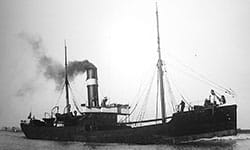

Betsy Anna Dive
June 11, 2023 @ 2:00 pm - 5:00 pm
| £45Betsy Anna Dive
- Max Depth – 25m
- Tonnage – 880
- Length – 206
- Date sunk – 12 Oct 1926
- Type of vessel – Steam Ship
- How sunk – Floundered in heavy seas
- Former names – None
- Wreck height – 6m
Diving the Betsy Anna – A Wreck Diver’s Dream
The Betsy Anna is a popular wreck diving site located off the coast of Massachusetts in the United States. The site is known for its rich history and excellent diving conditions, making it a favorite among both beginner and experienced divers.
History of the Betsy Anna
The Betsy Anna was a schooner that was built in 1877 and was used for fishing and transporting cargo along the eastern coast of the United States. In 1916, while carrying a load of coal, the Betsy Anna ran aground in a storm and sank off the coast of Gloucester, Massachusetts.
Location and Access
The wreck of the Betsy Anna is located in about 50 feet of water, approximately a quarter-mile offshore from Wingaersheek Beach in Gloucester, Massachusetts. Access to the site is by boat only, and there are several charter boats in the area that offer trips to the wreck.
Diving Conditions
The diving conditions at the Betsy Anna are generally good, with good visibility and calm seas. The water temperature ranges from around 50°F in the winter to 70°F in the summer, making it a year-round diving destination. The wreck itself is largely intact and is home to a variety of marine life, including lobsters, crabs, and schools of fish.
Diving Experience
Diving the Betsy Anna is suitable for divers of all skill levels, although some experience with wreck diving is recommended. The wreck is relatively shallow, with the top of the mast sitting at around 25 feet, making it accessible to even novice divers. However, the currents can be strong at times, so divers should be aware of their surroundings and follow proper diving procedures.
Conservation
The Betsy Anna is a protected wreck site, and divers are encouraged to respect the site and avoid disturbing the marine life and artifacts. The wreck is home to a number of lobster traps, which are used by local fishermen, and divers should take care not to damage or disturb these traps.
Conclusion
Diving the Betsy Anna is a unique and rewarding experience for any diver interested in wreck diving. The site’s rich history, excellent diving conditions, and abundant marine life make it a must-visit destination for any diving enthusiast.
FAQs
- What is the Betsy Anna?
- The Betsy Anna was a schooner that sank off the coast of Gloucester, Massachusetts in 1916.
- What is the diving experience like at the Betsy Anna?
- Diving the Betsy Anna is suitable for divers of all skill levels, although some experience with wreck diving is recommended.
- How can the Betsy Anna be accessed?
- Access to the site is by boat only, and there are several charter boats in the area that offer trips to the wreck.
- Is the Betsy Anna a protected wreck site?
- Yes, the Betsy Anna is a protected wreck site, and divers are encouraged to respect the site and avoid disturbing the marine life and artifacts.
- What marine life can be found at the Betsy Anna?
- The wreck is home to a variety of marine life, including lobsters, crabs, and schools of fish.

